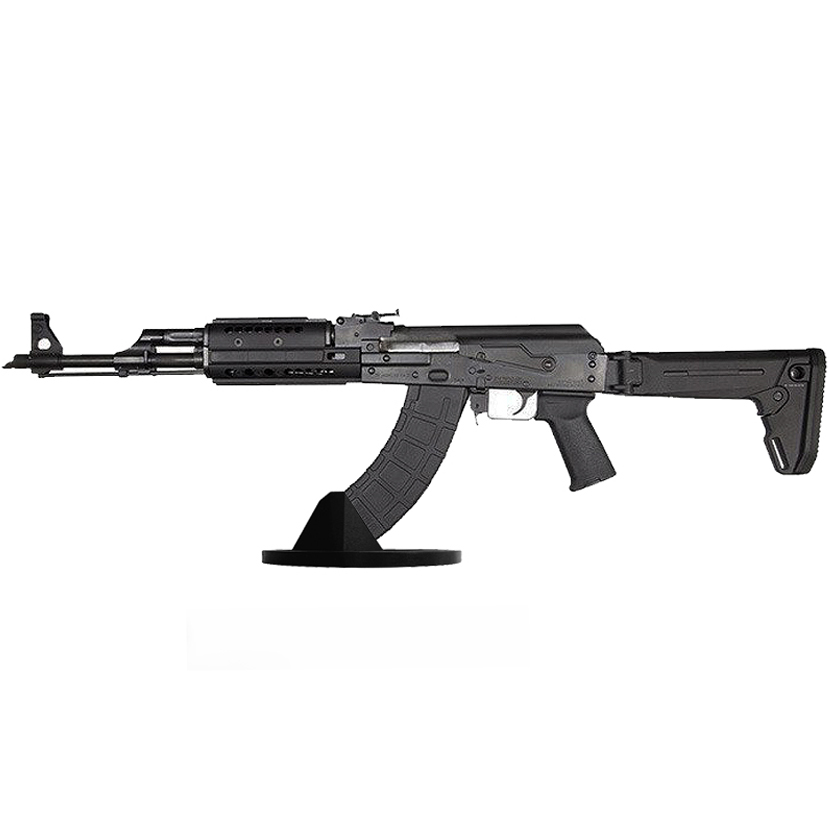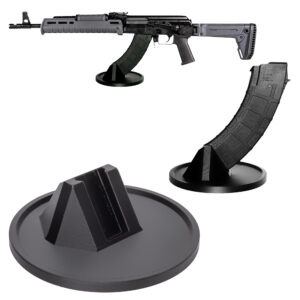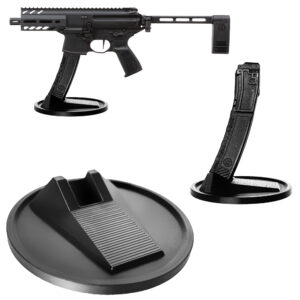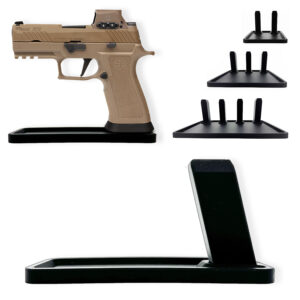
Categories:
Assault rifles are a class of guns designed for rapid fire and combat effectiveness, characterized by their intermediate cartridge size, select-fire capability, and effective range. Originating in the mid-20th century, these weapons have become pivotal in modern military and tactical operations due to their versatility and power. The AK-47 (Avtomat Kalashnikova 1947), developed by Mikhail Kalashnikov, is one of the most iconic assault rifles ever made.
Its rugged design, ease of use, and reliability under harsh conditions have cemented its place in military history. However, one aspect that often comes under scrutiny is its accuracy.
Accuracy in guns refers to the ability to consistently hit a target at varying distances. Several factors influence an assault rifle’s accuracy: barrel length and quality, sighting systems, ammunition consistency, ergonomics, recoil management, and even environmental conditions such as wind or humidity. When comparing the AK-47 to other assault rifles like the M16/M4 series from the United States or Germany’s Heckler & Koch G36C series, differences in design philosophy become apparent.
The AK-47 was engineered with simplicity and durability as primary goals. Its loose tolerances allow it to function reliably even when exposed to dirt or sand but can also lead to less precision compared to more finely-tuned weapons like the M16/M4 series. The latter features tighter manufacturing tolerances and superior sighting systems that enhance accuracy but may require more meticulous maintenance.
Moreover, while recoil management is another crucial factor affecting accuracy during rapid fire scenarios—where assault rifles typically shine—the AK-47’s higher-caliber 7.62x39mm rounds generate more recoil compared to the 5.56x45mm NATO rounds used by many Western counterparts like the M16/M4 series or G36C.
In essence, understanding how different assault rifles balance attributes such as reliability and precision provides valuable insights into their respective accuracies on the battlefield. This foundational knowledge sets the stage for a deeper comparison between these iconic guns’ performance metrics in various combat scenarios.
The AK-47, or Avtomat Kalashnikova 1947, was developed by Mikhail Kalashnikov in the Soviet Union and has since become one of the most iconic guns in history. Its inception dates back to the aftermath of World War II, a period marked by intense military innovation and competition among global superpowers. The Soviet Union sought to develop a reliable, easy-to-produce weapon that could be used by its infantry forces to gain an edge over Western adversaries.
Kalashnikov, then a tank sergeant recovering from injuries sustained during the war, began designing what would become the AK-47 in 1945. Drawing inspiration from various existing designs, including the German Sturmgewehr 44 (StG 44) and earlier Soviet prototypes like the SKS carbine, Kalashnikov aimed to create a gun that combined elements of both rifles and submachine guns. The result was a gas-operated assault rifle that could fire intermediate cartridges with significant stopping power while maintaining manageable recoil.
The AK-47 was officially adopted by the Soviet Armed Forces in 1949. Its design emphasized simplicity and durability; it could function reliably under harsh conditions such as mud, sand, and extreme temperatures—an essential feature for warfare environments ranging from urban battlegrounds to dense jungles and arid deserts. The weapon’s ease of use made it accessible even to poorly trained soldiers, further increasing its appeal.
Throughout the Cold War era, the AK-47 became more than just a tool of war; it evolved into a symbol of revolutionary movements worldwide. It was supplied en masse to various socialist allies and insurgent groups across Africa, Asia, and Latin America as part of Soviet foreign policy strategy aimed at countering Western influence.
Despite being designed over seven decades ago, the AK-47 remains prevalent today due to its robust construction and widespread distribution. However, its historical roots are deeply embedded in mid-20th century geopolitics—a time when nations were fervently seeking technological advancements to secure their military dominance on an increasingly polarized global stage.
The accuracy of the AK-47, when compared to other assault rifles, can be significantly influenced by various design features inherent to its construction. One of the primary factors affecting accuracy is the rifle’s barrel quality. The AK-47 traditionally uses a chrome-lined barrel which enhances durability and corrosion resistance but can slightly compromise precision due to variations in the internal surface finish.
In contrast, many modern assault rifles use non-chrome-lined barrels or employ advanced rifling techniques that offer tighter tolerances and greater consistency in shot placement.
Another critical design element is the action type. The AK-47 utilizes a long-stroke gas piston system, which is renowned for its reliability under adverse conditions but introduces more moving mass during firing compared to short-stroke systems or direct impingement mechanisms found in rifles like the M16 or AR-15. This additional mass can result in greater recoil and vibration, potentially affecting follow-up shot accuracy.
The ergonomics and stock design also play a pivotal role in shooting precision. The AK-47’s stock is often criticized for not providing as stable and comfortable a shooting platform as those found on Western rifles such as the FN SCAR or HK416. Modern assault rifles frequently incorporate adjustable stocks with improved cheek welds and length-of-pull adjustments, allowing shooters to customize their fit for better control and stability.
Sighting systems are another area where differences emerge. The standard iron sights on an AK-47 are simpler but less precise than those on some Western counterparts like the M4 carbine, which often come equipped with more refined aperture sights or are easily adaptable to advanced optics without extensive modifications.
Lastly, manufacturing tolerances contribute significantly to overall rifle accuracy. The AK-47’s design prioritizes loose tolerances for enhanced reliability under harsh conditions; however, this can lead to inconsistencies that affect shot groupings. High-end assault rifles typically emphasize tighter manufacturing standards that enhance repeatability and precision.
In summary, while the AK-47 excels in durability and reliability due to its robust design features, these same characteristics can introduce factors that limit its accuracy when compared directly with other contemporary assault rifles designed with precision shooting in mind.
Performance in various shooting conditions is a crucial factor when evaluating the accuracy of the AK-47 compared to other assault rifles. The AK-47, designed by Mikhail Kalashnikov, is renowned for its durability and reliability across diverse environments. However, its accuracy can vary significantly depending on the conditions under which it is used.
In controlled settings with minimal external interference, the AK-47’s accuracy tends to be less precise than that of modern assault rifles like the M16 or the HK416. These rifles often feature advanced engineering and materials that enhance precision. For instance, their barrels are typically manufactured with tighter tolerances and superior rifling techniques, which contribute to better bullet stabilization and consistency in shot placement.
As a result, in ideal conditions such as a shooting range or a calm environment where elements like wind and dust are controlled, these rifles generally outperform the AK-47 in terms of accuracy.
However, performance can shift dramatically when moving from controlled settings to more challenging environments. The AK-47’s design prioritizes simplicity and robustness over pinpoint precision. In extreme conditions—such as muddy swamps, sandy deserts, or freezing tundras—the rifle’s loose tolerances become an asset rather than a drawback. Its ability to continue functioning reliably without frequent maintenance means that it can still deliver reasonable accuracy even when other guns might suffer from malfunctions or decreased performance due to environmental factors.
Moreover, the ergonomic aspects of modern assault rifles often offer improved handling characteristics that aid in maintaining accuracy during rapid fire or maneuvering scenarios. Features like adjustable stocks and advanced sighting systems contribute positively in this regard. The AK-47 lacks some of these refinements; however, its straightforward design allows for quick training and adaptability among diverse user groups.
In summary, while the AK-47 may not match the pinpoint accuracy of more modern assault rifles under ideal conditions, its robust construction ensures consistent performance across various challenging environments where other guns might falter. This balance between reliability and acceptable accuracy has cemented its reputation worldwide as a dependable combat weapon suitable for myriad operational contexts.
When discussing the accuracy of the AK-47 in comparison to other assault rifles, it is crucial to consider user experience and handling, as these factors significantly impact overall performance. The AK-47 is renowned for its robust construction and reliability under adverse conditions, a design philosophy that prioritizes functionality over pinpoint accuracy. This ruggedness does have implications for how the rifle handles and ultimately how accurately it can be fired.
One of the defining characteristics of the AK-47 is its simplicity and ease of use. The rifle’s controls are straightforward, which can be advantageous for less experienced shooters or those operating in high-stress environments where quick reflexes matter more than precision. However, this same simplicity can also limit the rifle’s ergonomic sophistication compared to more modern assault rifles like the M4 or HK416.
The basic stock design and less refined grip may not provide as stable a firing platform, potentially affecting shot consistency.
Recoil management is another aspect where user experience plays a critical role in accuracy. The AK-47’s 7.62x39mm cartridge generates more recoil than lighter rounds like the 5.56x45mm NATO used by many Western rifles. While manageable with training, this increased recoil can lead to greater muzzle rise during rapid fire, making it harder for operators to maintain tight groupings on target without compensatory techniques.
Furthermore, while iron sights on an AK-47 are durable and functional within typical engagement ranges (100–300 meters), they lack the precision adjustments found on some other platforms equipped with advanced optics or sophisticated sighting systems out-of-the-box. Modern rifles often come with integrated Picatinny rails or modular systems that facilitate easy attachment of scopes and red-dot sights, enhancing their practical accuracy through better target acquisition.
In summary, while an AK-47’s durability and user-friendly design make it highly effective in various combat scenarios, these same attributes can compromise its peak accuracy when compared to contemporary assault rifles designed with enhanced ergonomics and advanced sighting systems in mind. Thus, user experience and handling are pivotal factors that influence how accurately one can shoot an AK-47 relative to its peers.








Colt
Colt M4 Carbine
Colt LE6920
Colt AR-15 A4
Daniel Defense
DDM4 V7
DDM4 V9
DDM4 V11
DDM4 ISR (Integrally Suppressed Rifle)
Smith & Wesson (S&W)
M&P15 Sport II
M&P15 Tactical
M&P15T
Bravo Company Manufacturing (BCM)
BCM Recce-16
BCM Recce-14
BCM MCMR Series
Aero Precision
M4E1 Series
AC-15
AR15 Pistol (Various Configurations)
Ruger
Ruger AR-556
Ruger SR-556
Ruger AR-556 MPR (Multi-Purpose Rifle)
Springfield Armory
Saint Victor
Saint Edge
Saint AR-15
PSA (Palmetto State Armory)
PSA PA-15
PSA AR-V
PSA Jakl (AR Pistol)
FN America
FN 15 Tactical Carbine
FN 15 Patrol
FN 15 DMR
Wilson Combat
Recon Tactical
Super Sniper
Protector Carbine
SIG Sauer
SIG M400 Tread
SIG M400 Elite
SIG M400 SDI
LWRC International
IC DI (Direct Impingement)
IC SPR
IC A5
Bushmaster Guns
XM-15 QRC
Bushmaster MOE
XM-15 Patrolman
Rock River Arms
LAR-15 Entry Tactical
LAR-15 Predator
LAR-15 Elite Comp
Stag Arms
Stag 15 Tactical
Stag 15L (Left-Handed Models)
Stag 15 Valkyrie
Noveske Rifleworks
Noveske Gen 4 N4
Noveske Space Invader (AR Pistol)
Noveske Recon
Anderson Manufacturing
AM-15 Optic Ready
AM-15 M4 Carbine
AM-15 Precision Rifle
Adams Arms
AA-15 Piston Rifle
P2 AARS (Adams Arms Rifle Series)
Black Rain Ordnance
SPEC15 Series
BRO Predator
Fallout 15
Diamondback Guns
DB15 Series
DB15CCMLB
DB15EB
Del-Ton Inc.
DTI-15
Del-Ton Echo 316H
Sierra 316M
Windham Weaponry
Windham SRC
Windham VEX-SS
Windham RMCS-4 (Caliber Conversion System)
Christensen Arms
CA-15 G2
CA-15 Recon
CA-15 Titanium Edition
Patriot Ordnance Factory (POF-USA)
Renegade Plus
P415 Edge
Revolution DI
LaRue Tactical
PredatAR
OBR (Optimized Battle Rifle)
LaRue Stealth 2.0
Battle Arms Development
Workhorse Patrol Carbine
BAD556-LW (Lightweight)
Authority Elite Rifle
Faxon Guns
Ascent AR-15
FX-19 (AR Pistol)
Streamline Ultralight Series
KE Arms
KE-15 SLT (Super Lightweight Tactical)
KE-15 Scout Carbine
Primary Weapons Systems (PWS)
MK1 MOD 2-M
MK116 PRO
MK107 (Piston AR Pistol)
ZEV Technologies
ZEV Core Elite Rifle
ZEV AR15 Billet Rifles
Franklin Armory
BFSIII AR-C1
Militia Model
F17-L (Chambered in .17 WSM)
Seekins Precision
SP15 DMR
NX15 Skeletonized Rifle
Havak Bravo
Aero Precision (Additional Models)
EPC-9 (Pistol Caliber ARs)
VG6 AR Rifles
Barrett Guns
REC7 DI
REC7 Gen II
CMMG
MK4 RCE
Resolute 300
Banshee (AR Pistol)
DPMS Panther Arms
Panther Oracle
Panther LR-308
H&K (Heckler & Koch)
HK MR556A1
HK416 (Military Variant)
Rock Island Armory (Armscor)
VR-80 Tactical AR (Shotgun AR Platform)
Troy Industries
Troy SPC-A3
Troy PAR (Pump Action AR)
Wilson Tactical
Tactical Recon AR
Protector Series
F1 Guns
FDR-15 Skeletonized Rifle
BDRx-15 Series
Juggernaut Tactical
JT-15
JT-10 Precision Rifle
AeroSurplus
Surplus AR-15 Rifles (Budget Models)
Thunder Tactical
AR-15 Basic Carbine
Tactical Builder Sets
Radical Guns
RF-15
Forged AR-Series
Dark Storm Industries
DS-15 Featureless Rifles
DS-10 Typhoon
DRD Tactical
Paratus
Aptus AR Rifles
Bear Creek Arsenal
BCA-15
AR Complete Upper Builds
Aero Survival Rifles (ASI)
ASR Tactical Series
Tactical Edge
WARFIGHTER Series
AR-15 Lightweight Rifles
Lone Star Armory
TX15 DMR
TX15 Carbine
HERA Arms
HERA H7
HERA AR-15 Lower Builds
IWI (Israeli Weapon Industries)
Zion-15
DRD Tactical
Tactical Modular Rifles
Quick-Takedown Rifles
V Seven Weapons
1776 Rifle
Hyperlite Rifle
Core Rifle Systems
Core15 Tac III
Core15 Patrol Rifle
Armalite (Original AR-15 Creator)
M15 Tactical
M15 A4 Carbine
DEF15 (Defensive Sporting Rifle Series)
PSA (Palmetto State Armory Additional Models)
PSAK-47 Hybrid (AR-AK Style Hybrid)
PSA Dagger (Pistol Caliber Configurations)
Odin Works
OTR-15
Odin Recon Rifle
Maxim Defense
MDX-508 PDX (Compact AR Pistol)
MDX-510 Rifle